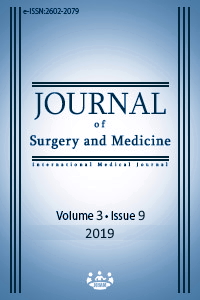Evaluation of changes in perfusion index in patients with cytotoxic tissue damage after snake bite: A prospective cohort study
Keywords:
Snakebite, Antivenom, Perfusion index, VenomAbstract
Aim: Pain, edema, and heat loss that develop and gradually increase in the extremities following a snake bite reduce microcirculation. The perfusion index indicates the intensity of the pulsatile signal relative to the nonpulsatile signal. The aim of this study was to measure the changes in perfusion index (PI) in the extremities of patients suffering from a snake bite who are treated in an intensive care unit, to detect early ischemia or necrosis in the affected organ, and to investigate the effectiveness of the administered antivenom.
Methods: Twenty patients admitted to our hospital with cytotoxic swelling of the upper or lower extremities after a snake bite were included in this prospective cohort study. Initial treatment was provided to the patients based on the snake bite treatment protocol. PI values of the affected extremity of each patient were measured for 24 hours using a finger probe and compared with the unaffected extremity in the same region. Patient age, gender, bites, antivenom administration times, and complications were also recorded and compared.
Results: Of all patients, 13 (65%) were male and 7 (35%) were female. The mean age of the patients was 37.5 (14.15) years. Eight patients (40%) were bitten in the lower extremity, and 12 patients (60%) were bitten in the upper extremity. PI values measured at the 19th, 23rd, and 24th hours were significantly higher in the affected extremity than in the unaffected extremity (P=0.043, P=0.049 and P=0.018, respectively). PI values measured at the 20th, 21st, and 22nd hours were insignificantly higher in the affected extremity than in the unaffected extremity (P=0.088, P=0.096 and P=0.085, respectively). An increase in the ratio between the PI of the unaffected extremity and that of the affected extremity was associated with a decrease in complications. One patient who had a snake bite in the right upper extremity developed necrosis and another patient developed compartment syndrome.
Conclusion: PI is a rapid, painless, and continuous measurement that provides clinicians with valuable information on both the effectiveness of the antivenom and perfusion of the extremity. Patients with local reactions such as swelling and bruising should be monitored for at least 24 hours, and clinicians should pay attention to the development of compartment syndrome or tissue necrosis in the following hours.
Downloads
References
Sarkhel S, Ghosh R, Mana K, Gantait K. A hospital based epidemiological study of snakebite in Paschim Medinipur district, West Bengal, India. Toxicol Rep. 2017;4:415-9.
Türkmen A, Temel M. Algorithmic approach to the prevention of unnecessary fasciotomy in extremity snake bite. Injury. 2016;47:2822-7.
Ince B, Dadacı M, Altuntaş Z, Bilgen F. The management of viperidae envenomation. Turk Plast Surg. 2015;23:1-5.
Altun D, Altun D, Ayaz B. Our Clinical Experiences in Snake Bites. J Turk Soc Intens Care. 2016;14:100-4.
Tanen DA, Danish DC, Grice GA, Riffenburgh RH, Clark RF. Fasciotomy worsens the amount of myonecrosis in a porcine model of crotaline envenomation. Ann Emerg Med. 2004;44:99–104.
Macho JR, Schechter WP. Care of patients with environmental injuries. In: Current Critical Care Diagnosis & Treatment, 2nd edition. Edited by Bongard FS, Sue DY. International edition. New York, McGraw-Hill, 2002;875-77.
Kus A, Gurkan Y, Gormus SK, Solak M, Toker K. Usefulness of perfusion index to detect the effect of brachial plexus block. J Clin Monit Comput. 2013;27:325-8.
Okur Mİ, Yıldırım MA, İnce B. Formation of a Treatment Algorhythm for Snake Bite Envenomation in Turkey. Turkiye Klinikleri J Med Sci. 2012;32:775-81.
Buyuk Y, Kocak U, Yazıcı YA, Gulpınar SS, Kır Z. A Death Case Resultıng From Snake Bite. Turkiye Klinikleri J Foren Med. 2007;4:127-30.
Al-Joufi A, Bailey GS, Reddi K, Smith DC. Neutralization of kinin releas¬17. ing enzymes from viperid venoms by antivenom IgG fragments. Toxicon. 1991;29:1509-11.
Scharman EJ, Noffsinger VD. Copperhead snakebites: clinical se¬verity of local effects. Ann Emerg Med. 2001;38:55-61.
Offerman SR, Smith TS, Derlet RW. Does the aggressive use of polyvalent antivenin for rattlesnake bites result in serious acute side effects. West J Med. 2001;175:88-91.
Fırat C, Erbatur S, Aytekin AH, Kılınç H. [Effectiveness of early fasciotomy in the management of snakebites]. Ulus Travma Acil Cerrahi Derg. 2012;18:417-23.
Vohra R, Rangan C, Bengiamin R. Sonographic signs of snakebite. Clin Toxicol (Phila). 2014;52:948-51.
Wood D, Sartorius B, Hift R. Ultrasound findings in 42 patients with cytotoxic tissue damage following bites by South African snakes. Emerg Med J. 2016;33:477-81.
Genderen VME, Bartels SA, Lima A, Bezemer R, Ince C, Bakker J, et al. Peripheral perfusion index as an early predictor for central hypovolemia in awake healthy volunteers. Anesth Analg. 2013;116:351-6.
Hasanin A, Mohamed SAR, El-Adawy A. Evaluation of perfusion index as a tool for pain assessment in critically ill patients. J Clin Monit Comput. 2017;31:961-5.
Menezes IAC, Cunha CLD, Junior HC, Luy AM. Increase of Perfusion Index During Vascular Occlusion Test is Paradoxically Associated With Higher Mortality in Septic Shock After Fluid Resuscitation: A Prospective Study. Shock. 2019;51:605-12.
Chu CL, Huang YY, Chen YH, Lai LP, Yeh HM. An observational study: The utility of perfusion index as a discharge criterion for pain assessment in the postanesthesia care unit. PLoS One. 2018;13:e0197630.
Downloads
- 1119 1763
Published
Issue
Section
How to Cite
License
Copyright (c) 2019 Mahmut Alp Karahan, Evren Büyükfırat
This work is licensed under a Creative Commons Attribution-NonCommercial-NoDerivatives 4.0 International License.
















